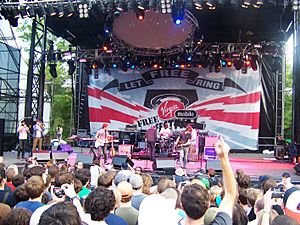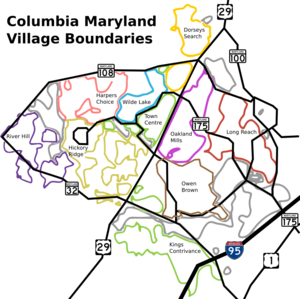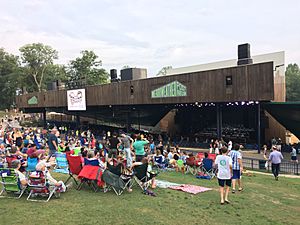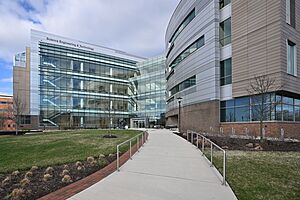Columbia, Maryland facts for kids
Quick facts for kids
Columbia, Maryland
|
|
|---|---|

Aerial view of Downtown Columbia
|
|
| Motto(s):
"The Next America!"
|
|

Location of Columbia, Maryland
|
|
| Country | |
| State | |
| County | Howard |
| Founded | June 21, 1967 |
| Founded by | James Rouse |
| Named for | Columbia (personification) |
| Area | |
| • Total | 32.19 sq mi (83.37 km2) |
| • Land | 31.93 sq mi (82.71 km2) |
| • Water | 0.26 sq mi (0.66 km2) |
| Elevation | 407 ft (124 m) |
| Population
(2020)
|
|
| • Total | 104,681 |
| • Density | 3,278.04/sq mi (1,265.68/km2) |
| The CDP includes areas not part of Columbia proper as defined by the Columbia Association. | |
| Time zone | UTC−5 (Eastern (EST)) |
| • Summer (DST) | UTC−4 (EDT) |
| ZIP Codes |
21044-21046
|
| Area codes | 410, 443, 667 |
| FIPS code | 24-19125 |
| GNIS feature ID | 0590002 |
Columbia is a special kind of city called a planned community in Howard County, Maryland, United States. It's made up of 10 separate villages. In 2020, about 104,681 people lived here, making it the second largest community in Maryland after Baltimore.
Columbia is located almost exactly between Baltimore and Washington, D.C.. The United States Census Bureau calls it a census-designated place, which means it's a specific area tracked for population data. The main part of Columbia is managed by the Columbia Association.
Columbia was started in 1967 by James Rouse. He had a big idea: to build a city that would make people's lives better. He wanted to focus on human values, not just money or building. Columbia was designed to avoid problems like neighborhoods being separated by race or income. Rouse also hoped it would help the county grow in an organized way.
Contents
History
How Columbia Began
Long ago, before Europeans arrived in the 1600s, the land where Columbia now stands was used by Native American groups like the Piscataway and Susquehannock for farming and hunting.
James W. Rouse, who founded Columbia, was born in Easton, Maryland. In 1935, he started working for the Federal Housing Administration. This job taught him a lot about building homes. Later, he started his own company, which developed shopping centers and malls. By the 1950s, Rouse was also involved in groups that wanted to improve cities. He believed that cities should be places where people could live and grow happily.
In the early 1960s, Rouse decided to create a brand new, model city. He wanted it to be a place where people could succeed. After looking at other places, he chose Howard County, Maryland, because it was between Baltimore and Washington, D.C.
Buying the Land
In 1962, Rouse's company began secretly buying land in Howard County. They used different companies to buy small pieces of land from many owners. This helped keep the prices low. Over a year and a half, they bought about 14,178 acres (57.38 km²), which was 10% of Howard County!
The secret land purchases were revealed in October 1963. People had wondered if the land would become a research lab or a giant compost pile! In 1965, the plan for Columbia was approved.
Opening and Growing
Columbia officially opened on June 21, 1967. James Rouse explained that it would be a "planned new city" with jobs, schools, shops, medical services, and many types of homes. He promised that businesses would pay taxes to help fund services for the community.
To plan Columbia, Rouse brought together a group of experts in social sciences. This "Work Group" met regularly and came up with new ideas for schools, recreation, religion, and health care. For example, they suggested the idea of open classrooms in schools and a new type of health care plan called a health maintenance organization (HMO).
Columbia has never officially become a city with its own mayor. Instead, a non-profit group called the Columbia Association (CA) manages many shared areas and services. The CA acts like a homeowner association for the whole community. The first village built in Columbia was Wilde Lake. The community center there, Slayton House, is named after John Estabrook Slayton, who helped plan Columbia.
The Master Plan
Columbia's main plan was to create ten self-contained villages. Each village would have everything people needed for daily life. The center of Columbia would be The Mall in Columbia and a man-made lake called Lake Kittamaqundi.
Villages and Neighborhoods

The idea behind the villages was to give Columbia a friendly, small-town feel. Each village has several neighborhoods. A village center might have middle and high schools, a shopping center, places for fun, a community center, and paths for walking and biking. Some villages even have "interfaith centers," which are shared places of worship for different religious groups.
Most neighborhoods in Columbia have different types of homes, like single-family houses, townhomes, and apartments. The original plan aimed for all children in a neighborhood to go to the same school, helping to create a strong community.
Here are the villages and their neighborhoods:
- Wilde Lake (Opened 1967): Bryant Woods, Faulkner Ridge, Running Brook
- Harper's Choice (Opened 1968): Longfellow, Swansfield, Hobbit's Glen
- Oakland Mills (Opened 1969): Thunder Hill, Talbott Springs, Stevens Forest
- Long Reach (Opened 1971): Phelps Luck, Jeffers Hill, Locust Park, Kendall Ridge
- Owen Brown (Opened 1972): Dasher Green, Elkhorn, Hopewell
- Town Center (Opened 1974): Vantage Point, Banneker, Amesbury, Creighton's Run, Warfield Triangle
- Hickory Ridge (Opened 1974): Clemens Crossing, Hawthorn, Clary's Forest
- Kings Contrivance (Opened 1977): Macgill's Common, Huntington, Dickinson
- Dorsey's Search (Opened 1980): Dorsey Hall, Fairway Hills
- River Hill (Opened 1990): Pheasant Ridge, Pointers Run
Many street names in Columbia come from famous books and poems. For example, Hobbit's Glen has streets named after characters from J. R. R. Tolkien's books, and Running Brook has names from Robert Frost's poetry.
Future Growth
"The Downtown Columbia Plan" is a plan from 2010 to improve and grow Downtown Columbia over the next 30 years. This plan includes adding more homes, offices, shops, hotels, and cultural places. The Howard Hughes Corporation, which now owns the land, is leading this big project.
Geography
Because Columbia isn't an official city, its exact borders can be a bit confusing. The Columbia Association manages a specific area, but the United States Census Bureau includes a larger area when it counts the population. This larger area includes some older communities that were there before Columbia was built.
Columbia is in the middle of Maryland. It's about 20 miles (32 km) southwest of Baltimore and 25 miles (40 km) northeast of Washington, D.C. The area has rolling hills and stream valleys. The roads in Columbia are curvy because they follow the natural shape of the land.
There are three man-made lakes in Columbia: Lake Kittamaqundi, Lake Elkhorn, and Wilde Lake. These lakes were created by building dams on streams. Columbia also has many areas with trees, like Symphony Woods and the large Middle Patuxent Environmental Area, which protects a river valley.
Climate
Columbia has a humid subtropical climate. This means it has cool winters and hot, humid summers. Sometimes, there's a lot of snow in winter.
| Climate data for Columbia, MD | |||||||||||||
|---|---|---|---|---|---|---|---|---|---|---|---|---|---|
| Month | Jan | Feb | Mar | Apr | May | Jun | Jul | Aug | Sep | Oct | Nov | Dec | Year |
| Mean daily maximum °F (°C) | 42 (6) |
46 (8) |
55 (13) |
66 (19) |
75 (24) |
84 (29) |
88 (31) |
87 (31) |
79 (26) |
68 (20) |
58 (14) |
46 (8) |
66 (19) |
| Mean daily minimum °F (°C) | 25 (−4) |
27 (−3) |
35 (2) |
44 (7) |
55 (13) |
64 (18) |
69 (21) |
68 (20) |
60 (16) |
48 (9) |
38 (3) |
29 (−2) |
47 (8) |
| Average precipitation inches (mm) | 3.16 (80) |
3.14 (80) |
4.10 (104) |
3.81 (97) |
4.56 (116) |
4.23 (107) |
4.05 (103) |
3.43 (87) |
4.60 (117) |
3.98 (101) |
4.21 (107) |
3.77 (96) |
47.04 (1,195) |
| Source: weather.com | |||||||||||||
Demographics
| Historical population | |||
|---|---|---|---|
| Census | Pop. | %± | |
| 1970 | 8,815 | — | |
| 1980 | 52,518 | 495.8% | |
| 1990 | 75,883 | 44.5% | |
| 2000 | 88,254 | 16.3% | |
| 2010 | 99,615 | 12.9% | |
| 2020 | 104,681 | 5.1% | |
| U.S. Decennial Census | |||
2020 census
| Population by Race in Columbia MD (2020) | ||
| Race | Population | % of Total |
|---|---|---|
| Total | 104,681 | 100 |
| White | 45,228 | 43 |
| African American | 28,293 | 27 |
| Asian | 13,369 | 13 |
| Hispanic | 10,709 | 10 |
| Two or More Races | 6,015 | 6 |
| Other | 848 | 1 |
| Three or more races | 478 | < 1% |
| American Indian | 524 | ~ 1% |
2010 census
From 2009-2013, the average household income in Columbia was about $99,877. The average income per person was $46,374. About 6.6% of the population lived below the poverty line.
Economy
James Rouse wanted Columbia to be a city with many jobs, not just a place where people lived and commuted to other towns. A large area was set aside for businesses and factories. The General Electric appliance plant, which opened in 1972, was a big part of this plan. It provided many jobs until it closed in 1990. Today, that area is a large office complex called Gateway Commerce.
Many people in Columbia work for the U.S. federal government. There are several large military and research facilities nearby, like the National Security Agency at Fort George G. Meade. Many residents also commute to jobs in Baltimore and Washington, D.C.
Some companies based in Columbia include W.R. Grace and Company, Sourcefire, and Nielsen Audio.
Shopping
The Mall in Columbia is a big shopping mall in the Town Center. It has many stores, restaurants, and a movie theater.
There are also other large shopping centers in East Columbia, like Dobbin Center and Snowden Square.
Columbia's nine "village centers" offer convenient shopping for residents. These centers usually have supermarkets, gas stations, restaurants, and hair salons. They are designed so that individual stores are not easily seen from the road. This makes them look less busy than typical strip malls.
Over time, some village centers have changed. The Rouse Company sold its village centers in 2002. Some centers, like Kings Contrivance, have been updated, while others, like Long Reach, are being redeveloped.
Arts and culture
Entertainment and Performing Arts

Merriweather Post Pavilion is a famous outdoor concert venue that hosts many popular performers. Columbia also has several theater groups, like Toby's Dinner Theatre and the Columbia Center for Theatrical Arts.
The Candlelight Concert Society, a non-profit group, offers chamber music concerts and other music programs for the community.
Howard County Library System
The Howard County Library System (HCLS) is known as one of the best public library systems in the country. Two of its six branches are in Columbia: the Central Branch and the East Columbia Branch.
Historic Sites
Columbia has four historic sites listed on the National Register of Historic Places: Christ Church Guilford, Dorsey Hall, Woodlawn, and the Oakland Mills Blacksmith House and Shop.
Religion
James Rouse wanted places of worship to be an important part of Columbia. He encouraged different religious groups to work together. In 1966, the Columbia Religious Facilities Corporation was created to help churches share interfaith centers. This allowed different faiths to use the same buildings for their services.
Parks and recreation
Columbia has many places for fun and exercise. The Columbia Association (CA) builds and takes care of most of these facilities. The CA operates 23 outdoor swimming pools, five indoor pools, water slides, ice and roller skating rinks, and an equestrian (horse riding) center.
There's also a sports park with miniature golf, a skateboard park, and batting cages. You can find three athletic clubs, many courts for tennis, basketball, volleyball, squash, pickleball, and racquetball, and running tracks.
The three lakes (Lake Kittamaqundi, Lake Elkhorn, and Wilde Lake) are great for sailing, fishing, and boating. There are also 80 miles (129 km) of paths for jogging, walking, and biking, plus 148 playgrounds for kids.
The village centers and neighborhood centers offer space for many community activities. Throughout the year, Columbia hosts various fairs and celebrations, including concerts at Lake Kittamaqundi and the Columbia Festival of the Arts.
Columbia also has garden plots that people can rent to grow their own plants. These are managed by the Columbia Gardeners. Freetown Farm, founded in 2016, teaches people about gardening and community. It's built on the site of Columbia's last working farm and has ties to the Underground Railroad.
Education
Public schools in Columbia are part of the Howard County Public School System. Here are some of the high schools that serve students in Columbia:
- Atholton
- Centennial
- Hammond
- Howard
- Long Reach
- Oakland Mills
- River Hill
- Wilde Lake
Colleges and Universities
While Columbia doesn't have a traditional four-year university, several colleges have facilities here. Howard Community College is located near the town center. Other universities, like the University of Phoenix and Johns Hopkins University, have facilities in the Columbia Gateway Business Park.
Infrastructure
Transportation
Public Transit
Columbia was originally planned to have a special bus system connecting its villages. While those specific routes weren't built, Howard County now operates bus routes under the Regional Transportation Agency of Central Maryland (RTA). These buses connect Columbia to nearby areas and to the MARC Train station at Dorsey.
Roads
Several major roads serve Columbia, making it easy to travel to Baltimore, Washington, D.C., and Annapolis.
- U.S. Route 29 (Columbia Pike) runs north-south, connecting Columbia to Ellicott City and Washington, D.C.
- Interstate 95 runs north-south, connecting Columbia to Baltimore and Washington, D.C.
- MD 32 (Patuxent Freeway) runs east-west, connecting Columbia to Sykesville and Annapolis.
- MD 100 (Paul T. Pitcher Memorial Highway) runs east from U.S. Route 29 to Glen Burnie.
- MD 175 (Rouse Parkway) is a main road that runs east-west through Columbia, from the Town Center to Jessup.
- MD 108 (Clarksville Pike-Waterloo Road) forms the northern edge of Columbia, running east-west from Clarksville to Ellicott City.
Healthcare
Medical care is available at Howard County General Hospital, which is connected to Baltimore's Johns Hopkins Hospital. The Columbia Medical Plan was started in 1967 to provide health care for residents. Today, there are other medical facilities like Kaiser Permanente and various clinics.
Notable people
- Stephen Amidon, author
- Bob Beaumont (1932–2011), founder of Citicar
- Jayson Blair, former New York Times reporter
- Zach Brown, NFL linebacker
- Michael Chabon, Pulitzer Prize–winning author
- Dan Charnas, journalist and author
- Frank Cho, comic strip creator
- George Colligan, jazz pianist
- Cristeta Comerford, White House executive chef
- Jack Douglass, internet personality
- Mary Downing Hahn, author of young adult books
- Brent Faiyaz, singer and record producer
- Kevin Frazier, journalist and TV broadcaster
- Gallant, Grammy-nominated singer-songwriter
- Alicia Graf Mack, dancer
- Justin Gorham (born 1998), basketball player
- Tom Green, ultra-runner
- Greg Hawkes, keyboardist for The Cars
- David Hobby, photographer
- Stephen Hunter, Pulitzer Prize–winning film critic and author
- Julia Ioffe (born 1982), journalist
- Kerry G. Johnson, caricaturist and illustrator
- Robert Kolker, author and editor
- Mark Levine, New York City Council member
- Laura Lippman, mystery author
- Steve Lombardozzi, former professional baseball player
- Steve Lombardozzi Jr., professional baseball player
- Suzanne Malveaux, CNN reporter
- Aaron Maybin, NFL defensive end
- Aaron McGruder, animator and cartoonist
- Edward Norton, actor and grandson of James Rouse
- Alexis Ohanian, co-founder of Reddit
- Toby Orenstein, theater director
- Randy Pausch, professor and author of The Last Lecture
- Ian Jones-Quartey, writer and animator
- Elise Ray, Olympic gymnast
- James W. Rouse, urban planner and founder of Columbia
- Peter Salett, singer-songwriter
- Greg Saunier, drummer for Deerhoof
- Christian Siriano, fashion designer
- Dave Sitek, guitarist and music producer
- Linda Tripp, central figure in a political event
- Terry Virts, astronaut
- Void, punk band
- Greg Whittington, basketball player
- David Byrne, musician
- Air Commodore Sir Frank Whittle, inventor of the jet engine
- Oprah Winfrey, talk show host and media executive
Sister cities
Columbia has "sister city" relationships with several cities around the world. These partnerships help promote cultural exchange and understanding. The Columbia Association helps organize programs, like summer exchanges for students.
- Cergy-Pontoise, France (since 1977)
- Tres Cantos, Spain (since 1990)
- Tema, Ghana (since 2014)
- Cap-Haïtien, Haiti (since 2016)
- Liyang, China (since 2018)
Related cities
The company that developed Columbia, The Rouse Company (now part of the Howard Hughes Corporation), also developed other planned communities. These include The Woodlands, Texas, Bridgeland Community, Texas, and Summerlin, Nevada.
See also
 In Spanish: Columbia (Maryland) para niños
In Spanish: Columbia (Maryland) para niños









